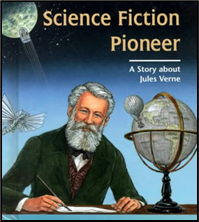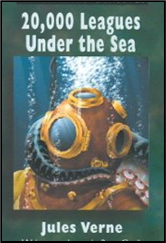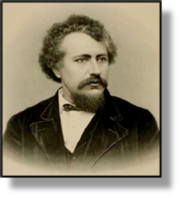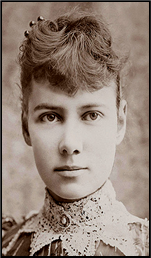


xxxxxThe French author Jules Verne was the leading pioneer in science fiction. His 50 exciting tales of adventure into the unknown included Five Weeks in a Balloon (1862), Journey to the Centre of the Earth (1864), Earth to the Moon (1865), Twenty Thousand Leagues under the Sea (1870), Mysterious Island (1874), and his best known work, Around the World in Eighty Days, published in 1873. These Extraordinary Voyages were well researched and proved immensely popular. They also anticipated many future scientific developments, including the atomic powered submarine, flights into space, guided missiles and inventions like helicopters and moving pictures. He also wrote some thirty plays and a large number of short stories and opera librettos, but he had completed his major works by the 1880s. He lived at Amiens from 1872 and was made an officer of the Légion d’Honneur in 1892. As we shall see (1895 Vc), his ability to popularize science by flights of fancy and exciting adventure was to be skilfully continued by the English author and social critic H.G. Wells.
JULES VERNE 1828 -
Acknowledgements
Train: contained
in History of the City of Omaha, Nebraska,
published 1894, by James Woodruff Savage and John Thomas
Bell – Nebraska State Historical Society, University of Nebraska-
 xxxxxThe French author Jules Verne is rightly regarded as
the father of science fiction. Earlier writers, such as Nathaniel
Hawthorne and Edgar Allan Poe, had shown some interest in this
genre, but it was Verne who, going well beyond the limits of
current scientific knowledge, plumbed the oceans, journeyed to the
centre of the earth, and rocketed to the moon. His Extraordinary
Voyages -
xxxxxThe French author Jules Verne is rightly regarded as
the father of science fiction. Earlier writers, such as Nathaniel
Hawthorne and Edgar Allan Poe, had shown some interest in this
genre, but it was Verne who, going well beyond the limits of
current scientific knowledge, plumbed the oceans, journeyed to the
centre of the earth, and rocketed to the moon. His Extraordinary
Voyages -

xxxxxHe wrote over 50 romantic tales of adventure. Among his most popular are Five Weeks in a Balloon (1862), Journey to the Centre of the Earth (1864), Earth to the Moon (1865), Twenty Thousand Leagues Under the Sea (1870), Mysterious Island (1874), and Around the World in 80 Days (1873). The last named, which follows the amusing adventures and mixed fortunes of the suave English gentleman Phineas Fogg and his French valet Passepartout, is probably the best known and best loved of all his works. As one would expect such flights of the imagination, coupled with high drama, have provided excellent material for cinema and TV.
xxxxxVerne was
born in Nantes, the son of a prosperous lawyer. He attended a
local boarding school and then in 1847 was sent to study law in
Paris. There, however, under the influence of two of his friends,
the established writers Victor Hugo and Alexandre Dumas, he began
writing for the stage, much to the annoyance of his father. He did
complete his law studies, but then made his living writing opera
librettos, comedies and stories. He achieved a modicum of success
in 1850 with his play The Broken Straws,
but he was obliged to augment his income by other means. He was
secretary at the Théâtre Lyrique for a
couple of years (1852-
 xxxxxThe turning point in his literary career came in
1862. In that year he met and became a close friend of the editor
and publisher Pierre Jules Hetzel. He saw merit in Verne’s work,
but advised him to weave his interest in science and exploration
around a tale of adventure, full of exiting incident and with
touches of humour. The result was Five Weeks
in a Balloon, a fascinating journey across Africa that
proved the first of his many scientific fantasies. Published in
Hetzel’s bi-
xxxxxThe turning point in his literary career came in
1862. In that year he met and became a close friend of the editor
and publisher Pierre Jules Hetzel. He saw merit in Verne’s work,
but advised him to weave his interest in science and exploration
around a tale of adventure, full of exiting incident and with
touches of humour. The result was Five Weeks
in a Balloon, a fascinating journey across Africa that
proved the first of his many scientific fantasies. Published in
Hetzel’s bi-
xxxxxThere followed a series of imaginary journeys in the same vein. Carefully researched and liberally spiced with exciting adventures, each of these Voyages Extraordinaires proved extremely popular. Though full of fantastic ideas and situations, he managed to make his fantasies have some semblance of possibility, and this made them the more intriguing in an age of growing interest in scientific innovation. Nor were his outlandish ideas very wide of the mark. Captain Nimo’s pirate submarine Nautilus, for example, in Twenty Thousand Leagues Under the Sea anticipated the nuclear powered Nautilus of the 1950s, and his Mysterious Island of 1870 was full of future inventions, including television and the aqualung. And being shot into space by a large cannon in Earth to the Moon was not far removed from the launching pad at Cape Canaveral in the 1960s!

 xxxxxAll of Verne’s major works had been written by the
early 1880s, and after the death of his mother in 1887 his story lines took on a
more sombre tone, many of them taking a rather pessimistic view of
the future of civilisation. In 1888 he entered politics and served
for fifteen years as a councillor in Amiens, the town where he had
lived with his wife and family since 1872. In recognition of his
contribution to literature he was made an officer of the Légion
d’Honneur in 1892. In all he wrote 65 novels, some thirty
plays and a large number of short stories and opera librettos. His
last novel, The Invasion of the Sea,
was published in 1905, the year of his death. His science fiction
made him a rich man. He visited the United States in 1867, and in
the mid 1870s he made a tour of the Mediterranean in his own
yacht.
xxxxxAll of Verne’s major works had been written by the
early 1880s, and after the death of his mother in 1887 his story lines took on a
more sombre tone, many of them taking a rather pessimistic view of
the future of civilisation. In 1888 he entered politics and served
for fifteen years as a councillor in Amiens, the town where he had
lived with his wife and family since 1872. In recognition of his
contribution to literature he was made an officer of the Légion
d’Honneur in 1892. In all he wrote 65 novels, some thirty
plays and a large number of short stories and opera librettos. His
last novel, The Invasion of the Sea,
was published in 1905, the year of his death. His science fiction
made him a rich man. He visited the United States in 1867, and in
the mid 1870s he made a tour of the Mediterranean in his own
yacht.
xxxxxAn easy-
xxxxxIncidentally, in his writing Verne was influenced by the American
short-
xxxxx…… In 1863 Verne wrote Paris in the
Twentieth Century, the story of a young poet who comes to
a tragic end in a world which is obsessed with the advance of
technology -
xxxxx…… PierrexJules
Hetzel (1814-
xxxxx…… When Verne went to America in 1867 he travelled aboard the Great Eastern. This giant of a steamship had just completed the laying of the transatlantic cable and was chartered by Napoleon III to sail to New York and bring American visitors to the Paris Exhibition of that year. Later, Verne’s novel Une Ville flottante (The Floating City), published in 1874, was based on his voyage to the States. ……
 xxxxx…… AroundxThe World in Eighty Days
might well have been based on such a journey, made by the American
entrepreneur George Francis Train (1829-
xxxxx…… AroundxThe World in Eighty Days
might well have been based on such a journey, made by the American
entrepreneur George Francis Train (1829- commercial
undertakings, but spent his last few years in seclusion.
commercial
undertakings, but spent his last few years in seclusion.
xxxxx…… InxNovember 1889 a pioneer
female journalist named Nellie Bly (1867-
Vb-


